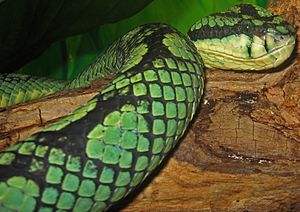Sri Lankan pit viper facts for kids
Quick facts for kids Trimeresurus trigonocephalus |
|
|---|---|
 |
|
| Scientific classification | |
| Kingdom: | |
| Phylum: | |
| Subphylum: | |
| Class: | |
| Order: | |
| Suborder: | |
| Family: | |
| Subfamily: | |
| Genus: |
Trimeresurus
|
| Species: |
T. trigonocephalus
|
| Binomial name | |
| Trimeresurus trigonocephalus (Donndorff, 1798)
|
|
The Trimeresurus trigonocephalus, commonly known as the "Sri Lankan Green Pit viper", is a species of venomous Pit vipers found in Sri Lanka. There are no subspecies currently recognized.
Contents
Description
Males are smaller than females who can grow to the length of around 130 cm, while males can grow up to the length of 80 cm. They are green in color, and their back has some shades of yellow, they also have black stripes all over them and have a black tail.
Behavior
The Sri Lankan Green Pit viper is nocturnal and arboreal (it lives in trees), but can sometimes be found on the ground looking for food like frogs, lizards, and small mammals, it also eats birds which it finds in the trees. In the morning Sri Lankan Green Pit vipers can be seen on top of trees so they can warm up their body with the sun rays that hit them.
Reproduction
The Sri Lankan Green Pit viper is viviparous, meaning they give live birth. They give birth to their young during June and July. The have around 5 to 25 young at a time.
Where they live
They are found in grasslands and rain forests of Sri Lanka
Common Names
The Sri Lankan Green Pit viper is also known as the "Pala Polonga" and the "Green Pit viper".
Venom
The venom of the Sri Lankan Green Pit viper is hemotoxic. The bite of a Sri Lakan Green Pit viper is very painful, when someone is bitten by a Sri Lankan Green Pit viper the bitten area swells up, and the pain may last for a few days. The cells of living tissue die, blisters occur, and ptosis and lymphadenopathy take place. However, there have been no reports on deaths.
Images for kids
See also
 In Spanish: Trimeresurus trigonocephalus para niños
In Spanish: Trimeresurus trigonocephalus para niños
 | Aurelia Browder |
 | Nannie Helen Burroughs |
 | Michelle Alexander |


